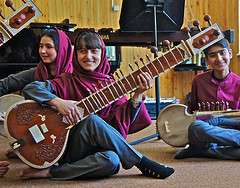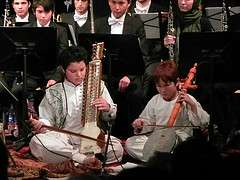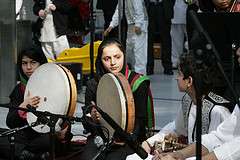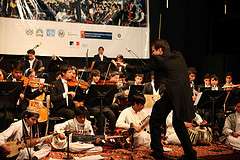|
Back
Textures From A Not-So-Lonely Planet New York
Isaac Stern Auditorium, Carnegie Hall
02/12/2013 -
Awal Mir (Arranged by Salim Sarmast): Da Zemong Ziba Wata
Afghan Folk Song: Laila Jan
Indo-Afghan Traditional: Raga
Frédéric Chopin (Arranged by Nathan Milstein): Nocturne
Afghan Traditional: Lariya for violin, rubab and chamber orchestra (Arranged by William Harvey)
Maurice Ravel Boléro (Arranged by William Harvey)
Ustad Zaland: Ay Saraban (Arranged by James Herzog)
Antonio Vivaldi: The Four Seasons of Afghanistan (Re-composed by William Harvey)
Afghan Folk Song: Shakoko Jan (Arranged by Salim Sarmast)
Ensembles of Afghanistan National Institute of Music, Ahmad Sarmast (Founder and Director), Mikhail Simonyan (Violin), Afghan Youth Orchestra, William Harvey (Conductor), Chamber Wind Ensemble, James Herzog (Conductor), Sitar and Sarod Ensemble, Ustad Irfan Khan (Leader), Young Afghan Traditional Ensemble, Ustad Muhammed Murad Sarkhosh (Leader), Members of the Scarsdale High School Orchestra

Sitarist (© James Herzog)
On a WNYC interview this week, William Harvey modestly “hoped” Maurice Ravel would have enjoyed his arrangement of Boléro for Afghan and Western instruments.
Balderdash! Mr. Harvey, a noted violinist himself, certainly knew that Ravel–who was entranced with (what we now call) world music–would have leaped on the stage and embraced all the rubab, sarod, tanbur and ghichak players with tears in his eyes.
True, Antonio Vivaldi might have felt initially puzzled at Mr. Harvey’s complete re-composition of Four Seasons. But almost immediately he would plan on writing concertos for dilruba, tabla, dhol and zerbaghali.
That was the effect of this most extraordinary and singularly attractive concert by a gaggle of Afghan groups, musicians from Scarsdale High School, New York, and soloists from Afghanistan, the United States and even Russia. Yet this was no “East-Western Divan Orchestra”, that group made up of Jews, Palestinians and other Arabs. They had learned to play Beethoven very well.

Ghichak players (© James Herzog)
Last night’s groups, all associated with the Afghanistan National Institute of Music, played a multi-layered, multi-textural and multi-inspired concert. Not everything was to everybody’s taste (I thought the opening Mantovani–hued folk song was pretentious pablum). But virtually every work on the evening’s program had a different texture, hue, feeling and shape.
In finality, unlike Barenboim’s ensemble, nobody could have predicted the sounds which came off the Carnegie Hall stage last night. Like those of us fortunate enough to have lived in Afghanistan in the 1960’s, every moment was a surprise, and frequently a joy. The major element, though, was that little could be considered traditional Afghan, only one work was traditional Western (a Chopin Nocturne for violin and piano), but the hybrids were actually new music.
By far was the most original and interesting was The Four Seasons of Afghanistan, re-composed by Mr. Harvey. He kept many of the original themes, but they were transposed, broadened, narrowed, played with different instruments. Replacing the solo violin, he used a variety of instruments. The throbbing of a tabla was the equivalent of low vibrato. A sitar (the Afghan variation on the Indian sitar) gave the atmospheric whirring of a sandstorm in the Afghan Summer.
And blessings on Mr. Harley, who kept the original structure of Vivaldi’s poems, my two favorite foods of Kandahar, pistachios and pomegranates, were given their own movements. Pistachios, the third movement of “Spring” was delightful. One expected the monotonously bumptious rhythm of Vivaldi. Here it was a Bartók-style 7/8 rhythm, syncopated, getting faster and faster. Pomegranates took the place of Vivaldi’s Harvest with an Afghan tune and more syncopation.
Mr. Harvey had a musical jeu de mots with “Winter”, using the solo ghichak to portray freezing weather. That instrument is used exclusively in the frozen northern mountains of the country, near Mazar-I-Sharif, so the frigid temperatures were implied. That same instrument played the plaintive second movement with a feeling of solitary splendor.
Outside of the solos, the Vivaldi/Harvey work had instrumental colors in the background including the most natural merger of Western and Eastern instruments. Unlike Tan Dun’s worthy attempts merging Chinese, Mongolian and Western instruments, here it formed a landscape which didn’t point out the differences, but were lovely and unexpected on their own.

Drummers (© Simone D. McCourtie/World Bank)
On the other side of the concert was a wonderful group of young Afghanis playing, purely, the Laila Jan. The whole ensemble finished with another traditional song, a song for clapping, where the audience, without urging joined in.
Now came the hybrids. Russian violinist Mikhail Simonyon started the Lariya like the beginning of Ravel’s Tzigane with a long solo, augmented then with a beautiful rubab solo by Zamin Safar, joined by a small Afghan ensemble. The color, the rhythm, and the near-improvisatory nature, with two virtuosi, offered the best of both worlds.
After that, came the authentic Ravel, a Boléro which was, without any reservations, very exciting, The rhythms were set (I believe) by two drums, tabla and dhol, and the repetitions were taken by a diverse group of native and Western instruments. Inevitably, toward the crescendo, the strings (including those of Scarsdale High School) took the lead, but the strumming and measured rhythms of the Afghani instruments gave it all the background necessary.

W.Harvey and Ensemble (© James Herzog)
Since these sounds have never been heard before in New York I have no way of describing the distinctive auras, the variegated textures and the interlacing of sounds. True, Afghan music is mainly pentatonic and their sometimes unfretted instruments were microtonally different from our own strings. But if anything, these sounds offered echoes, resonances, fluctuations as telling as our blues notes.
I leave the best for last. The finale of The Four Seasons of Afghanistan. Instead of a rousing finale, Mr. Harvey had composed a movement of almost silent intensity. The lute-like rubab is a virtual orchestra in itself, with three melody strings, four drone strings and dozens of “sympathetic” strings giving it vibrations and amplitude. The soloist played a cadenza which, instead of showing off the instrument, was quiet, thoughtful and finished almost in silence over a major chord.
The movement was titled Salaam. It was of course a prayer for peace. No people need It more. Thanks to last night’s concert, no people deserve it more.
Peace.
Harry Rolnick
|